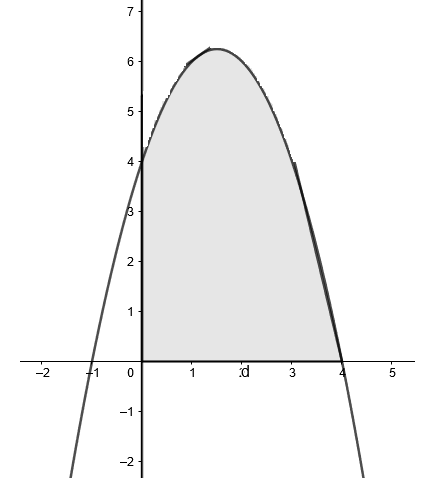
Compute the larger area bounded by \[y=4+3x-{{x}^{2}}\]and the coordinate axes.
Answer
607.2k+ views
Hint: Try to find where the curve cuts the $x$ axis. First try to make a rough sketch. Then find the area under the curve using integral.
Note that a quadratic function always represents a parabola.
So, first of all let’s try plotting the curve considering various values,
Note that at \[x=0,y=4\]
And at \[y=0,\left( x-4 \right)\left( x+1 \right)=0\] or \[x=4,-1\]
Use the above observations to plot the graph.

The shaded region is the required area.
Hence, we can now find the area by integrating the function from $x=0$ to $x=4$.
The formula of finding the area enclosed by $f(x)$ between $x=a$ and $x=b$ can be written as $=|\int\limits_{a}^{b}{f(x)dx|}$.
So the required area under the curve is,
\[\text{Area}=\int\limits_{0}^{4}{\left( 4+3x-{{x}^{2}} \right)dx}\]
Now we know the integration of sum of functions is sum of individual integration of the functions, i.e.,
\[\text{Area}=\int\limits_{0}^{4}{4dx}+\int\limits_{0}^{4}{\left( 3x \right)dx}-\int\limits_{0}^{4}{\left( {{x}^{2}} \right)dx}\]
On integrating, we get
\[Area=\left[ 4x \right]_{0}^{4}+3\left[ \dfrac{{{x}^{2}}}{2} \right]_{0}^{4}-\left[ \dfrac{{{x}^{3}}}{3} \right]_{0}^{4}\]
Applying the limits, we get
\[Area=\left[ 4(4)-4(0) \right]+3\left[ \dfrac{{{4}^{2}}}{2}-\dfrac{{{0}^{2}}}{2} \right]-\left[ \dfrac{{{4}^{3}}}{3}-\dfrac{{{0}^{2}}}{3} \right]\]
On solving, we get
\[Area=16+24-\dfrac{64}{3}\]
Taking the LCM, we get
\[Area=\dfrac{40\times 3-64}{3}\]
\[Area=\dfrac{40\times 3-64}{3}=\dfrac{120-64}{3}\]
\[Area=\dfrac{56}{3}\]sq. units
Therefore the area under the curve is \[\dfrac{56}{3}\] sq. units.
Note: The possibility of mistake is that students might take the lower limit as \[-1\] considering the curve and forget to note that it is asked to find the area of the curve with the coordinate axes, so the lower limit will be \[0\].
Note that a quadratic function always represents a parabola.
So, first of all let’s try plotting the curve considering various values,
Note that at \[x=0,y=4\]
And at \[y=0,\left( x-4 \right)\left( x+1 \right)=0\] or \[x=4,-1\]
Use the above observations to plot the graph.

The shaded region is the required area.
Hence, we can now find the area by integrating the function from $x=0$ to $x=4$.
The formula of finding the area enclosed by $f(x)$ between $x=a$ and $x=b$ can be written as $=|\int\limits_{a}^{b}{f(x)dx|}$.
So the required area under the curve is,
\[\text{Area}=\int\limits_{0}^{4}{\left( 4+3x-{{x}^{2}} \right)dx}\]
Now we know the integration of sum of functions is sum of individual integration of the functions, i.e.,
\[\text{Area}=\int\limits_{0}^{4}{4dx}+\int\limits_{0}^{4}{\left( 3x \right)dx}-\int\limits_{0}^{4}{\left( {{x}^{2}} \right)dx}\]
On integrating, we get
\[Area=\left[ 4x \right]_{0}^{4}+3\left[ \dfrac{{{x}^{2}}}{2} \right]_{0}^{4}-\left[ \dfrac{{{x}^{3}}}{3} \right]_{0}^{4}\]
Applying the limits, we get
\[Area=\left[ 4(4)-4(0) \right]+3\left[ \dfrac{{{4}^{2}}}{2}-\dfrac{{{0}^{2}}}{2} \right]-\left[ \dfrac{{{4}^{3}}}{3}-\dfrac{{{0}^{2}}}{3} \right]\]
On solving, we get
\[Area=16+24-\dfrac{64}{3}\]
Taking the LCM, we get
\[Area=\dfrac{40\times 3-64}{3}\]
\[Area=\dfrac{40\times 3-64}{3}=\dfrac{120-64}{3}\]
\[Area=\dfrac{56}{3}\]sq. units
Therefore the area under the curve is \[\dfrac{56}{3}\] sq. units.
Note: The possibility of mistake is that students might take the lower limit as \[-1\] considering the curve and forget to note that it is asked to find the area of the curve with the coordinate axes, so the lower limit will be \[0\].
Recently Updated Pages
A man running at a speed 5 ms is viewed in the side class 12 physics CBSE

The number of solutions in x in 02pi for which sqrt class 12 maths CBSE

State and explain Hardy Weinbergs Principle class 12 biology CBSE

Write any two methods of preparation of phenol Give class 12 chemistry CBSE

Which of the following statements is wrong a Amnion class 12 biology CBSE

Differentiate between action potential and resting class 12 biology CBSE

Trending doubts
What are the major means of transport Explain each class 12 social science CBSE

Which are the Top 10 Largest Countries of the World?

Draw a labelled sketch of the human eye class 12 physics CBSE

Explain sex determination in humans with line diag class 12 biology CBSE

Explain sex determination in humans with the help of class 12 biology CBSE

Differentiate between homogeneous and heterogeneous class 12 chemistry CBSE




